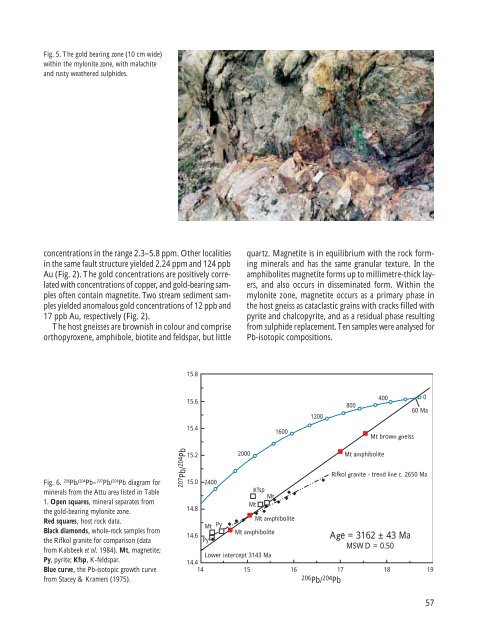Geological Survey of Denmark and Greenland Bulletin 11 ... - GEUS
Geological Survey of Denmark and Greenland Bulletin 11 ... - GEUS
Geological Survey of Denmark and Greenland Bulletin 11 ... - GEUS
Create successful ePaper yourself
Turn your PDF publications into a flip-book with our unique Google optimized e-Paper software.
Fig. 5. The gold bearing zone (10 cm wide)<br />
within the mylonite zone, with malachite<br />
<strong>and</strong> rusty weathered sulphides.<br />
concentrations in the range 2.3–5.8 ppm. Other localities<br />
in the same fault structure yielded 2.24 ppm <strong>and</strong> 124 ppb<br />
Au (Fig. 2). The gold concentrations are positively correlated<br />
with concentrations <strong>of</strong> copper, <strong>and</strong> gold-bearing samples<br />
<strong>of</strong>ten contain magnetite. Two stream sediment samples<br />
yielded anomalous gold concentrations <strong>of</strong> 12 ppb <strong>and</strong><br />
17 ppb Au, respectively (Fig. 2).<br />
The host gneisses are brownish in colour <strong>and</strong> comprise<br />
orthopyroxene, amphibole, biotite <strong>and</strong> feldspar, but little<br />
quartz. Magnetite is in equilibrium with the rock forming<br />
minerals <strong>and</strong> has the same granular texture. In the<br />
amphibolites magnetite forms up to millimetre-thick layers,<br />
<strong>and</strong> also occurs in disseminated form. Within the<br />
mylonite zone, magnetite occurs as a primary phase in<br />
the host gneiss as cataclastic grains with cracks filled with<br />
pyrite <strong>and</strong> chalcopyrite, <strong>and</strong> as a residual phase resulting<br />
from sulphide replacement. Ten samples were analysed for<br />
Pb-isotopic compositions.<br />
15.8<br />
15.6<br />
1200<br />
800<br />
400 0<br />
60 Ma<br />
15.4<br />
1600<br />
Mt brown gneiss<br />
Fig. 6. 206 Pb/ 204 Pb– 207 Pb/ 204 Pb diagram for<br />
minerals from the Attu area listed in Table<br />
1. Open squares, mineral separates from<br />
the gold-bearing mylonite zone.<br />
Red squares, host rock data.<br />
Black diamonds, whole-rock samples from<br />
the Rifkol granite for comparison (data<br />
from Kalsbeek et al. 1984). Mt, magnetite;<br />
Py, pyrite; Kfsp, K-feldspar.<br />
Blue curve, the Pb-isotopic growth curve<br />
from Stacey & Kramers (1975).<br />
207 Pb/<br />
204 Pb<br />
15.2<br />
15.0<br />
14.8<br />
14.6<br />
2400<br />
Mt<br />
Py<br />
Py<br />
2000<br />
Mt<br />
Kfsp<br />
Mt<br />
Mt amphibolite<br />
Mt amphibolite<br />
Lower intercept 3143 Ma<br />
14.4<br />
14 15 16 17 18<br />
19<br />
206 Pb/ 204 Pb<br />
Mt amphibolite<br />
Rifkol granite - trend line c. 2650 Ma<br />
Age = 3162 ± 43 Ma<br />
MSWD = 0.50<br />
57
















